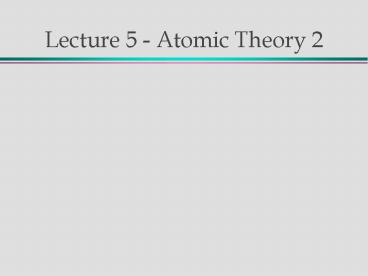Lecture 5 Atomic Theory 2 - PowerPoint PPT Presentation
1 / 33
Title:
Lecture 5 Atomic Theory 2
Description:
white light all wavelengths. atomic light source discreet ... Balmer Series (VIS) Paschen Series (IR) Balmer-Rydberg Equation. 1. l = R. 1. m2. 1. n2 ... – PowerPoint PPT presentation
Number of Views:276
Avg rating:3.0/5.0
Title: Lecture 5 Atomic Theory 2
1
Lecture 5 - Atomic Theory 2
2
Review
- small, massive nucleus
- electrons occupy most of the volume
- white light ? all wavelengths
- atomic light source ? discreet wavelengths
- Plancks equation E hn
3
Bohrs Atomic Model
Light Emission
Electron Excitation
n1
n2
n3
4
n¼
n5
n4
Paschen Series
n3
(IR)
Balmer Series (VIS)
n2
Lyman Series (UV)
n1
5
Balmer-Rydberg Equation
Relates l to upper and lower transition levels
1
1
1
-
R
l
n2
m2
Upper level
Lower Level
R 0.01097 nm-1
6
According to de Broglie,
- moving particles exhibit wave-like properties
- l h/(mv)
7
by the way,
- Energy Force x Distance
- ma x d
- kg x (m s-2) x m
- kg m2 s -2
- J
8
de Broglie Example
- An electron is moving at 2.74 x 106 m/s
- Find its wavelength!
- l h/(mv)
- 6.63 x 10-34 J s / (9.11 x 10-31 kg x 2.74 x
106 m/s) - 2.65 x 10-10 m 0.265 nm
9
Enter Erwin Schrodinger
- forget the particles - atoms themselves are like
waves - Schrodinger wave equation
10
Schrodinger wave equation
- Solve the wave equation,
- Get a wave function (Y)
- Y shape and size of space electron occupies
- (95 of the time, usually)
- Y an orbital
11
- The wave equation yields three quantum numbers
- n, l, m
12
Principal Quantum Number
- n
- n 1, 2, 3, 4, 5, 6,...
- n ? size and energy level of orbital
13
Angular Momentum Quantum Number
- l
- l 0, 1, 2,..., (n-1)
- (subshell number)
- l ? shape of orbital
14
Subshells
- subshell no. 0 1 2 3
- notation s p d f
15
Magnetic Quantum Number
- m
- m - l to l
- m ? orientation of orbital
16
Example 1
- if n1,
- l 0 only (an s-orbital)
- and
- m 0 only (1 orientation only)
17
1s Orbital
18
Example 2
- if n 2,
- l 0 (an s-orbital)
- or
- l 1 (a p-orbital)
19
2s Orbital
node
20
if l 1, m -1 or 0 or 1
- recall that l 1 implies a p-orbital
- thus, there are three p-orbitals
- they differ only in orientation
21
p orbital
Nucleus
22
Three p orbitals of one atom
23
Example 3
- if n3,
- l 0 or l 1
- or
- l 2 (a d-orbital)
- ml -2, -1, 0, 1 or 2
- (i.e. five d-orbitals)
24
Example 4
- if n4,
- l 0 or 1 or 2
- or
- l 3 (an f-orbital)
- ml -3, -2, -1, 0, 1, 2 or 3
- (i.e. 7 f-orbitals)
25
Summary
- 1 type of s orbital
- 3 types of p orbital
- 5 types of d orbital
- 7 types of f orbital
26
There is a fourth quantum number
- spin, ms
- ms 1/2 or -1/2
- (up or down)
27
Paulis Exclusion Principle
- no two electrons in an atom have the same four
quantum numbers
28
Filling Orbitals with Electrons
- Aufbau - filling up
- put two electrons in each type
- of each orbital (one of each spin)
29
Filling Orbitals with Electrons
- Hydrogen
- one electron in the 1s orbital
- electronic configuration is 1s1
30
Filling Orbitals with Electrons
- Helium
- two electrons in the 1s orbital
- electronic configuration is 1s2
- (first shell complete)
31
Filling Orbitals with Electrons
- Lithium
- two electrons in the 1s orbital,
- then one in the 2s orbital
- electronic configuration is 1s22s1
- or He 2s1
32
Filling Orbitals with Electrons
- Beryllium
- 1s22s2
- or
- He2s2
33
Filling Orbitals with Electrons
- Boron He2s22p1
- Carbon He2s22p2
- Nitrogen He2s22p3
- Oxygen He2s22p4
- Fluorine He2s22p5
- Neon He2s22p6 (second shell full)

